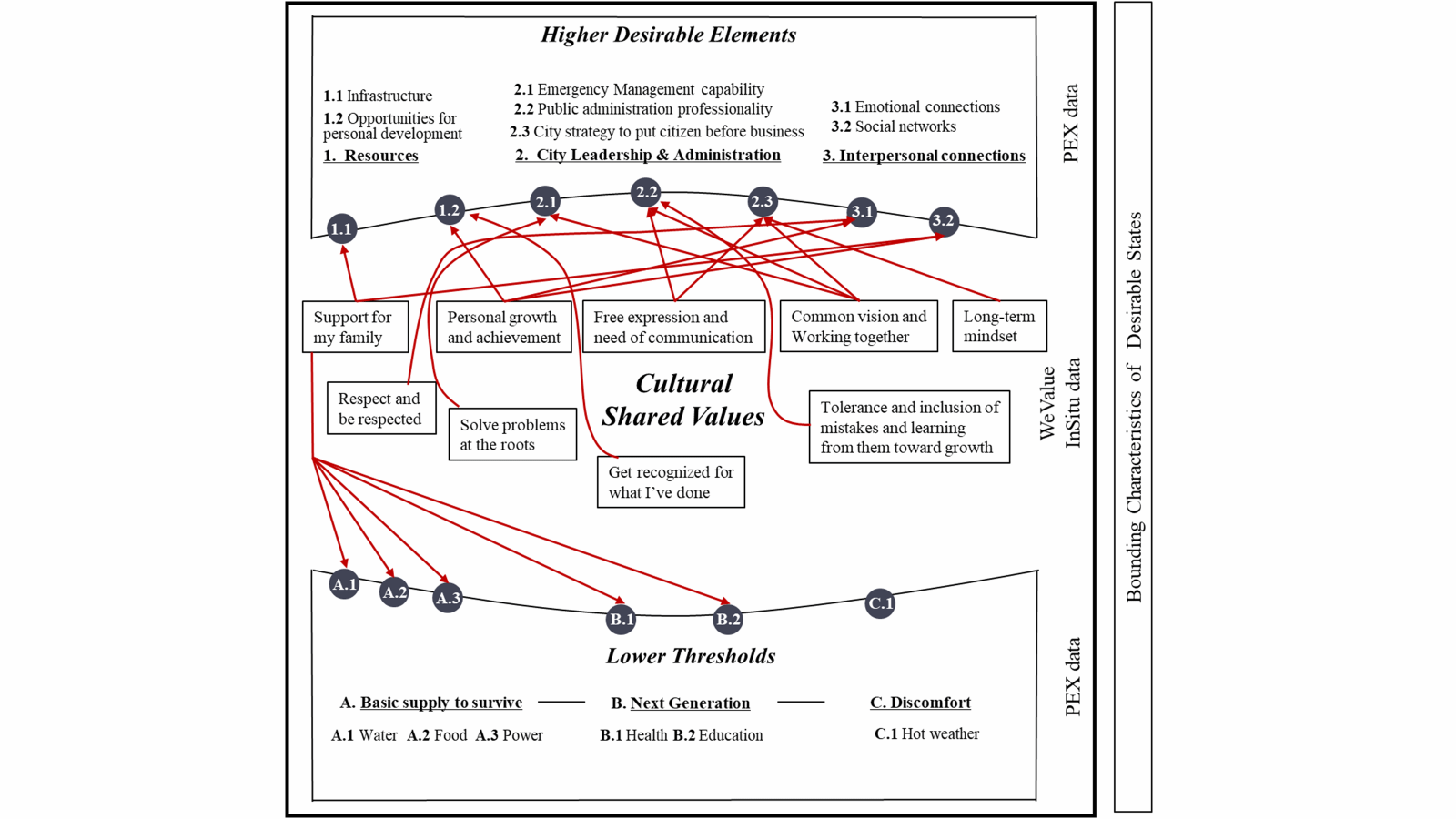
Keywords: liveability // shared values // urban metabolism // public perceptions // climate change // Austria // China // Sweden
Funded by: JPI Urban Europe and the National Natural Science Foundation of China (NSFC) (EC Contribution: €983,400)
Funding Period: 2019-2022
Key team members: MKH (Shared Values workstream on project), WWH, HYY
Partners: IVL Swedish Environmental Research Institute, International Institute for Applied Systems Analysis, Beijing Normal University, Fudan University, Jinan University
Key Contributions to WeValue Knowledge System:
In this project WeValue InSitu and the attached focus group discussions were intended to obtain indications of the shared values of residents which could provide bounds of acceptability for the ‘liveable’ cities. The modellers would be using quantitative economics-based methods to project final integrated solutions of resilient ‘liveable’ cities from the perspectives of the materials and energy flows, including carbon flows, but that approach would produce a large number of candidate solutions, and they would not yet be linked to the living preferences of the people. To balance that, WeValue InSitu was designed in to provide indicators of red lines and living preferences or residents. (Separately, policy exercises with experts would be held to provide their qualitative data input of boundaries.) Altogether it was hoped this information could indicate a pathway to building urban resilience to social, economic, and environmental stress.
It was during the work for this project that the team first realised the usefulness and importance of the WeValue data in defining a ‘Desirable State’ for a city. This concept had been raised in urban studies literature previously, but not developed. It centred on the idea that the ‘liveability’ of a city relied heavily on whether residents would be attracted or discouraged from arriving/staying, but as it was not previously easily definable, the concept did not develop. What the WeValue data showed, was that the statements that residents made about ‘coming/staying’ to the cities versus ‘leaving’ were very easily relatable to the shared values they articulated as data, and this provided useful linkages.
A very clear illustration of this was a respondent who said he would not be at al concerned if climate change effects caused flooding in Shanghai: his logic was that if his workplace closed, so would others, so it wasn’t important. But his group had expressed strong shared values concerning schooling for their children: when it was pointed out the schools might also close, he immediately declared this was not acceptable, and he would leave Shanghai rather than loose on schooling for his children: for him it was a ‘red line’.

Figure 1. A schematic of the shared values found in shanghai groups (centre box), defining the ‘Desirable State’ characteristics. The top and bottom show topic or attraction and detraction for living in the city.
COVID also forced this project to conduct some of the WeValue InSitu workshops over the internet – not exactly online ! – but with the local trainee facilitator wearing an earpiece while Prof Harder spoke instructions over a remote link. Although the workshops did their basic job, it was clear the delays in timing and rapport developed with this approach hindered the intersubjective exchanges which are usually nurtured in the process, and thus although Statements and Frameworks of Shared Values were obtained (and focus group data about liveability and climate change perspectives), the ‘gelling’ of the participants was noticeably less than usual, and no significant transformational effects were anecdotally mentioned afterwards, contrary to common experience.
Relevant papers published: See #27, #31 from the Publications List (also given below). There is also much depth in the thesis of Wu Wenhao.
31. Using desirable urban states to understand key linkages between resilience subsystems
Wu, W., Huang, Y., Fath, B. D., Schwarzfurtner-Lutnik, K. & Harder, M. K., 9 Jan 2024, In: Journal of Cleaner Production. 436, 140678.
DOI: https://doi.org/10.1016/j.jclepro.2024.140678
A demonstration of how crystallized shared values can be obtained for a city profile, defining ’Desirable States’ of a city, and a wider conceptual model which includes linkages from those shared values to perspectives of urban life.
27. Perceptions of climate change impacts on city life in Shanghai: Through the lens of shared values
Huang, Y., Wu, W., Xue, Y. & Harder, M. K., 13 Sept 2022, In: Cleaner Production Letters. 3, 100018.
DOI: https://doi.org/10.1016/j.clpl.2022.100018
A case study demonstrating the use of a carefully-designed focus group discussion with participants about climate change impacts on their life in the City, immediately following WeValue InSitu crystallization process. The result is a set of clear articulations with respect to life values, such that nuances and linkages between perceptions and values can be identified, producing a ‘Conceptual Map’ useful for planners (and researchers).
Official websites:
RECREATE | JPI Urban Europe [https://jpi-urbaneurope.eu/project/recreate/]
RECREATE - IVL.se [https://www.ivl.se/english/ivl/our-offer/research-projects/sustainable-urban-planning/recreate.html]
Official purpose (of the overall project):
The aim of this project is to identify roles, opportunities, and pathways for cities to foster circular economy:
1) to reduce significantly the energy, water, and material resource uses, and related environmental impacts;
2) to build resilience to ever-increasing uncertainties from globalization and climate changes; and,
3) to become more liveable for growing populations in different urbanization contexts in China and Europe.
It will involve working with the four cities of Beijing, Malmo, Shanghai, and Vienna. This will be achieved by developing, establishing, and implementing quantitative methods for urban metabolism, and proposing urban resource cycles, to provide foundations for building urban resilience to social, economic, and environmental stress. Through our cross-partner collaboration distributed in the four case-study cities, researchers will apply the methodologies to each other’s cities for comparative and synthesized knowledge creation. Integrated solutions will have embedded results from policy exercises and elicited stakeholder shared values which will provide bounds of acceptability for these ‘liveable’ cities.

Formal documents and publications
Can be found at:
jpi-urbaneurope.eu/wp-content/uploads/2019/04/RECREATE.pdf
and a Case Study Report Comparing the demonstration cities:
Combined-City-Report-final.pdf
https://www.ivl.se/download/18.3eb0eaa0176bc20189e4f9/1609835178656/Combined-City-Report-final.pdf
Further information: (of the overall project)
Aims/objectives
To:
• Identify key inherent strengths and the current sustainability status of the studied cities
• Analyse the urban systems in terms of metabolism, trade-offs of efficiency and redundancy, and ecological footprints.
• Identify pathways and key opportunities where cities can foster the transformation to be more liveable, circular, and resilient.
• Identify key current challenges hindering evolution to the circular economy.
• Assess the ecological footprints of future scenarios in the studied cities that embrace a circular economy/industrial symbiosis approach, whilst minimizing life cycle environmental impact and remaining within reasonable local boundaries of shared resources.
Expected results and impacts
• The project aims to advance our methodological and substantial understanding of urban resilience arnd propose options for improved policies particularly in the context of climate change.
• Robust analysis of current urban metabolisms and future scenarios, including integration of interaction of shared values of residents and stakeholders.
Partners
IVL Swedish Environmental Research Institute,
International Institute for Applied Systems Analysis,
Beijing Normal University,
Fudan University,
Jinan University
Chalmers University
This project has received funding in the framework of the Joint Programming Initiative Urban Europe: Sustainable and Liveable Cities and Urban Areas, with support from the European Union’s Horizon 2020 research and innovation programme under grant agreement No 857160.


